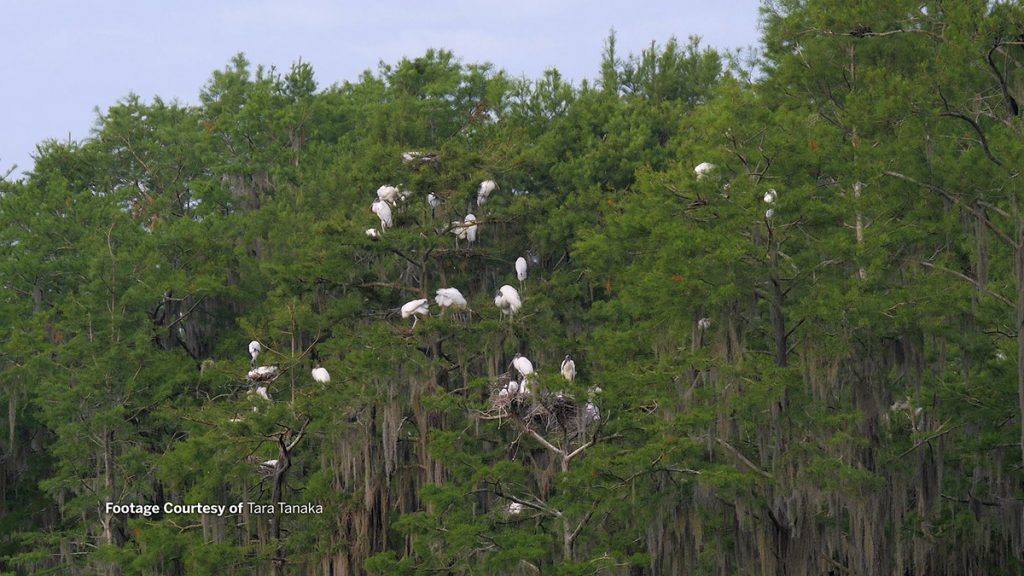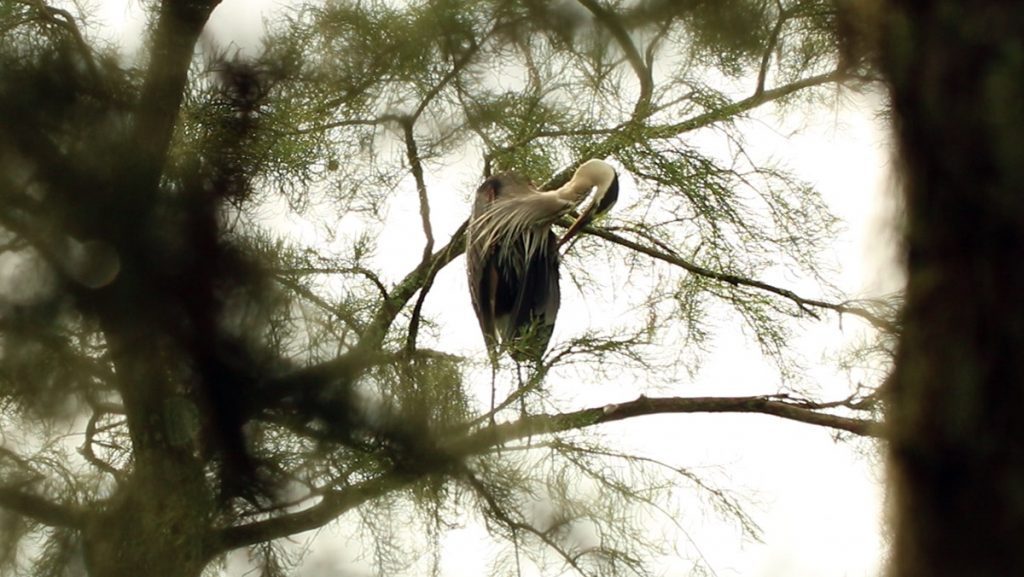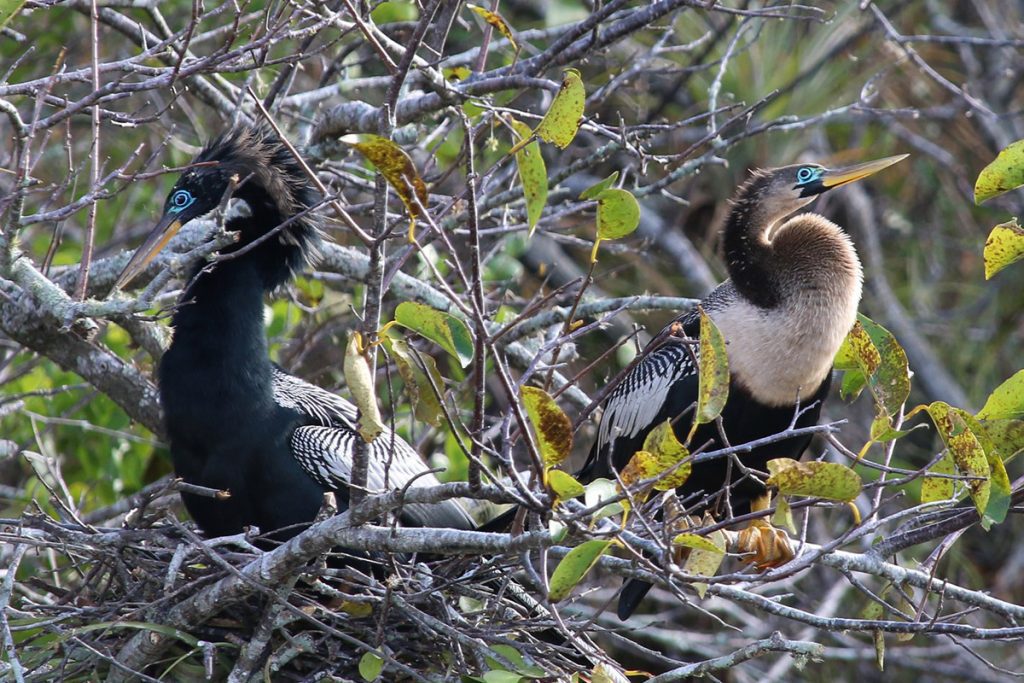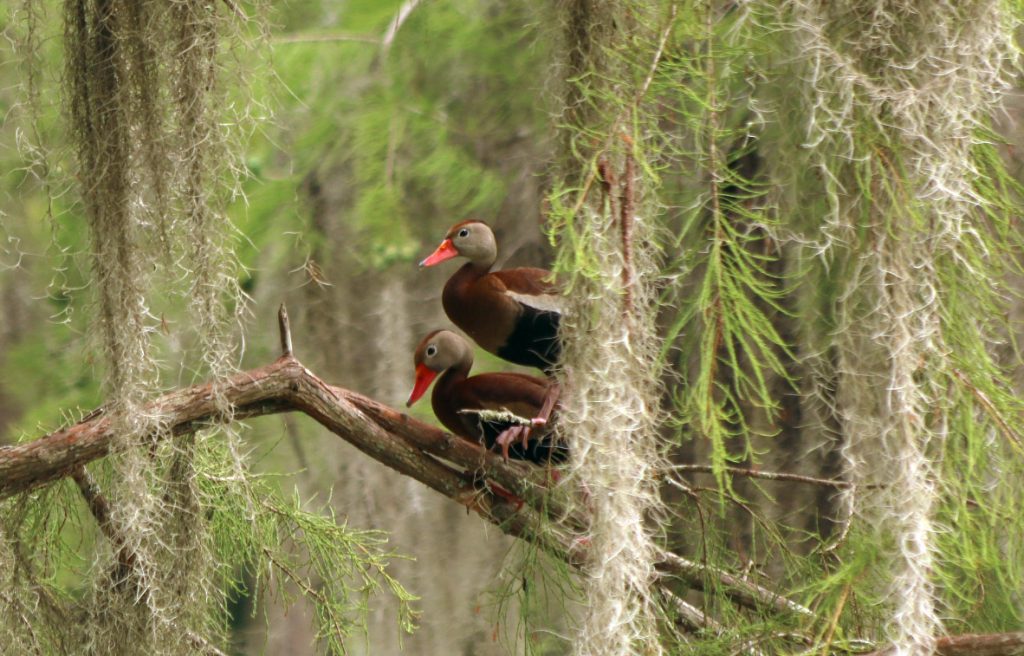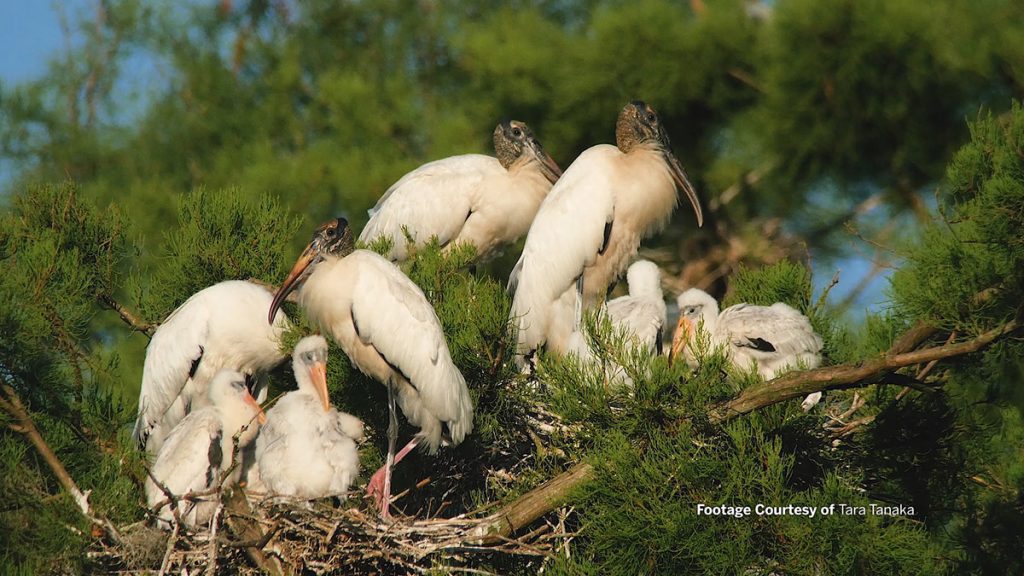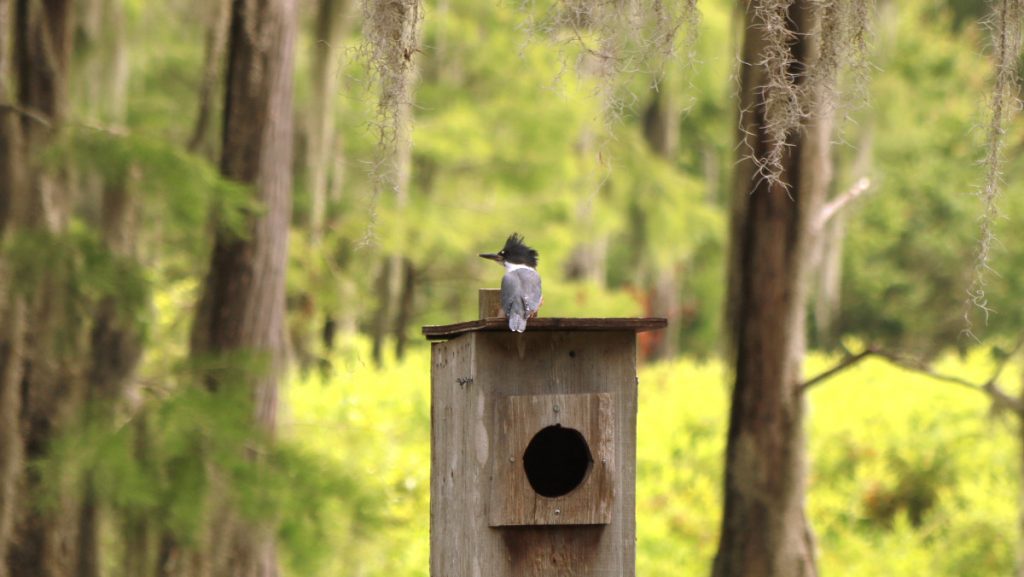In late spring and early summer, wood storks and other wading birds head to rookeries to nest. To see one, we head into a cypress swamp owned by a married couple, who manage it as a preserve. The following segment was edited and co-produced by Carlee Soeder.
Subscribe to the WFSU Ecology Blog to receive more videos and articles about our local, natural areas, and subscribe to the WFSU Ecology Youtube Channel.
Rob Diaz de Villegas WFSU Public Media
“In general,” Jim Stevenson says, “it is easy to manage a swamp.”
The swamp to which Jim refers is his backyard. For his wife, Tara Tanaka, it’s a photographer’s dream. Two duck blinds let her observe animals visiting directly behind their house. She also keeps the sliding door clean, and a camera attached to a birding scope is always ready to capture whatever happens by. One morning, it was a bobcat carrying a wood duck. Other days, there could be hundreds of wading birds foraging in shallow water. This includes ibis, roseate spoonbills, egrets, herons, and the animal that brings us here, the wood stork.
But they didn’t purchase 45 acres of cypress swamp simply to take amazing photos and videos. Jim, a retired biologist with the state park service, wanted to protect what he saw as an important ecological resource. We’re wading in with him to take a look.
Accompanying us is Misty Penton, who we last saw in our segment on Muscogee shell carving. She has also recently joined the WFSU Education and outreach team. She and Jim have been neighbors for a long time, living on a quiet street surrounded by wetlands and floodplain forest. In fact, when another parcel of that land was about to be developed, Misty mounted a grassroots effort to protect that as well. The story of the Fred George Greenway, and its geological connections to Lake Jackson, is up next on the WFSU Ecology Blog.
But today, we’re heading deep into Jim and Tara’s swamp during an important time of year. Wading birds are nesting.
Wood Storks in Tallahassee
For our recently completed EcoCitizen documentary, I spent months visiting Lake Elberta. The City of Tallahassee built this retention pond about twenty years ago with no great wildlife ambitions. Its job is to collect stormwater runoff from surrounding roads, and from Florida State University. In other words, the icky water. This wasn’t supposed to be a major hub for migratory ducks and neotropical migrants like purple martins. And yet, it has become one of Tallahassee’s top birding hotspots on eBird.
For most of the year, one of the highlights here is a bird you don’t need a high powered birding scope or binoculars to see. Wood storks are conspicuous birds. Locally, only great blue herons are taller (46 inches compared to 40 for the storks), though the bulkier wood storks weigh about the same. They have a striking combination of all white feathers- except a black trim under their wings- and a black, scaly head. They’re not cute, but they are impressive.
The bird’s range includes parts of the Georgia and South Carolina coasts, and both of Mexico’s coasts. It’s more sparsely found in Cuba and Hispaniola. In Florida, they’re found on the coasts in much of the peninsula. And then there’s Tallahassee and its immediate surroundings, the smallest bubble on the bird’s range map.
The Cornell Lab of Ornithology’s page on the bird recommends going into a swamp or wetland area to see them. Here in town, though, ditches and retention ponds are often the wetlands wood storks use for foraging. Over the last year, I’ve seen them poking their large beaks into the garbage filled muck at the edge of Lake Henrietta, in ditches off of Capital Circle by an office park, and in the retention pond between WFSU and the Mag Lab. At Lake Elberta Park, they can often be seen in the runoff ditch between the lake and Lake Bradford Road.
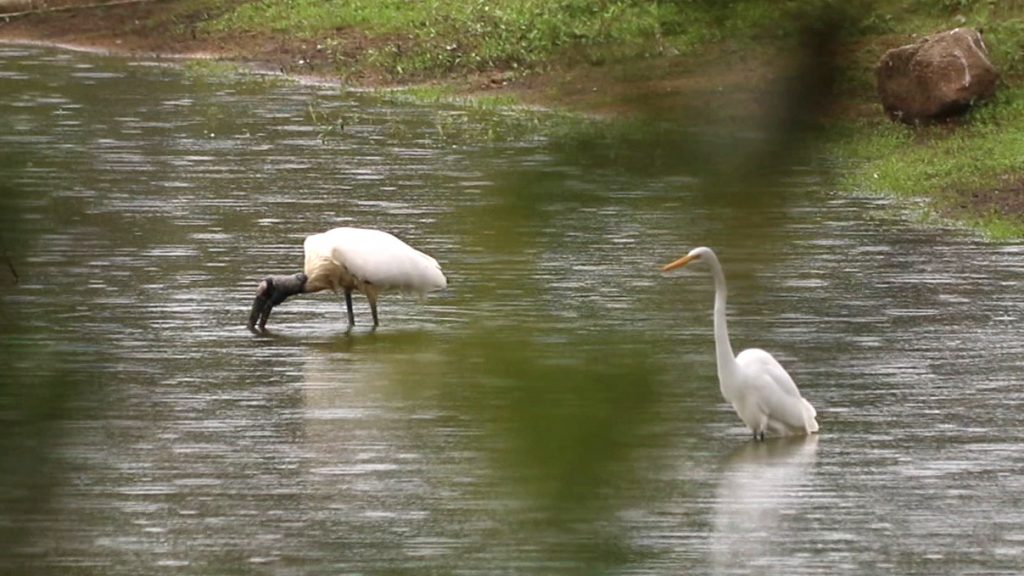
Wood stork (Left) and great egret forage in a retention pond by the FSU/ FAMU College of Engineering.
It’s an odd place to see an animal that’s iconic of the Everglades, and of deep swamp locales. But just because the wood stork has adapted itself to find food among our paved surfaces, don’t think it has become an urban bird.
Into the Wood Stork Rookery
In our first segment on Lake Elberta, I looked at the handy little charts eBird makes for each bird species at each of its hotspots. Wood storks are regularly observed at Lake Elberta during ten months of the year. Then, in May and June, the chart flatlines. This is when they, and several other wading and aquatic birds, head to rookeries.
As you see in the video, we’re wading in relatively shallow water. Shallow, but it’s still over the tops of my boots. Jim in his waders is the best prepared of our party. As with many wetlands in our area, this swamp doesn’t always hold water. And if it’s dry during the mating season, wood storks won’t nest here.
“If there’s water under the nest, that means there could be alligators in the water.” Jim tells me. “The alligators are the best allies of our wading birds in that they protect the nest, with eggs and young, from raiding raccoons.”
As we see at the 2:37 mark in the video, the alligator doesn’t necessarily consider itself a protector of wood storks. But as long as storks can stay up high in their trees, and there’s water below, the chicks have a good chance of surviving to adulthood.
More than alligators, the wood stork’s greatest ally here is space and a plentitude of trees. They may feed in dirty ditches, but they need an intact cypress swamp to nest in colonies like they do. And 45 acres inside of Capital Circle is valuable real estate for wading birds, if not in terms of human dollars. Jim and Tara found this out after Tara was concerned that the cypress would be clear cut, and they decided to buy the land.
“Fortunately, it didn’t cost a lot,” Jim says, “because society doesn’t place much value on swamps.”
Protecting the Floridan Aquifer
Wading birds aren’t the only beneficiaries of Jim and Tara’s buying the swamp. Alligators, otters, beavers, ducks, and many more call this place home. And then, in a sense, all Tallahassee residents receive some benefit from this or any other protected wetland around them.
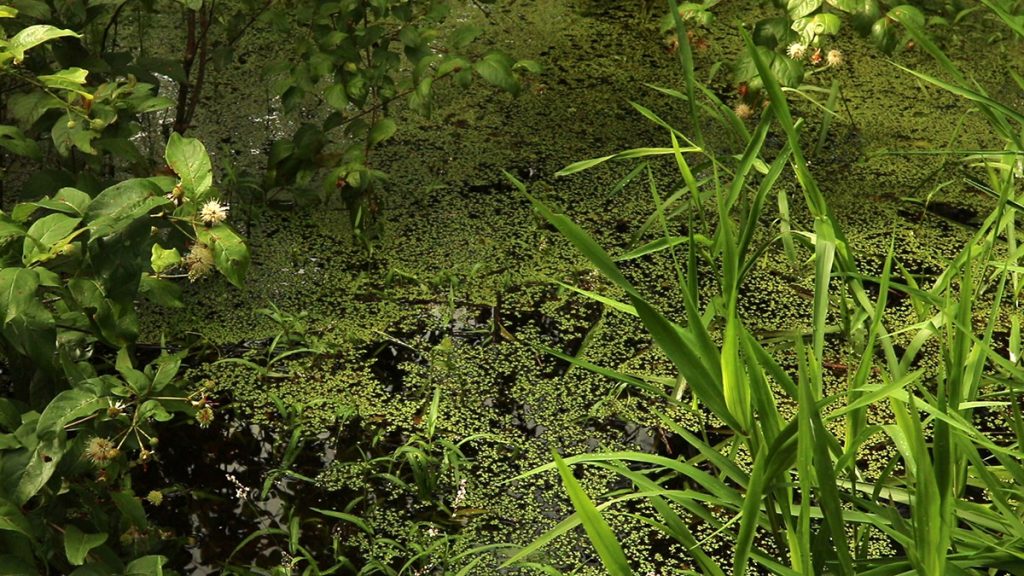
Grasses and other aquatic plants, like the duckweed on the water’s surface, absorb contaminants that flow into the swamp off of nearby roads. That runoff includes excess nutrients from fertilized lawns, which these aquatic plants use, reducing the risk of toxic algae blooms.
“The plants in the wetlands are purifying water by removing contaminants off of our streets, and from our lawns,” Jim says. This is a service provided by many wetland ecosystems, from swamps to salt marshes. While marshes and oyster reefs filter water flowing into our oceans, swamps help protect the water we as humans use every day. “We have two sinkholes in this swamp that take water down to the aquifer periodically. But also, water seeps through the bottom of the wetland, and it replenishes the aquifer in that manner as well.”
The Floridan aquifer is the source of our drinking water, as well as the water that flows out of our springs. If clean water goes in, then clean water comes out of our taps, as well as at our favorite summer swim holes (Wakulla Springs, Wacissa, Merritt’s Mill Pond, etc.).
Watershed protection motivated Misty to protect the Fred George Greenway as well. Again, that’s our next story. And in the story after that, we’re going into the aquifer itself. Researchers at Florida A&M University are discovering new species of cave creatures that might be swimming underneath you at this very moment.
The Floridan Aquifer is one of the largest is aquifers in the world, lying under 100,000 square miles of Florida and Georgia. People in this area use up to a billion gallons of water from it a year. Wetlands like Jim and Tara’s help protect this resource.
Wading Birds in the Rookery | Every One in Their Place
Now, let’s get back to the birds. The first thing we notice when we step out into an open space in the swamp is the noise. Over the constant pulsing sounds of frog calls, we can hear hungry wood stork chicks trying to get their mothers’ attention. Wood storks nest in colonies, and every cypress tree seems to have two or three nests. Every nest has two to three chicks, on average. They stake out the tops of the trees.
A rookery is the only place you’re going to see a wood stork chick. They start out with a full head of white, downy feathers.
As juveniles, they’ll accompany their parents on foraging trips. When you see groups of storks at Lake Elberta or Lake Henrietta, you’ll notice that not all of them have black, scaly heads. The younger storks are the ones with the grey feathers on the heads and necks.
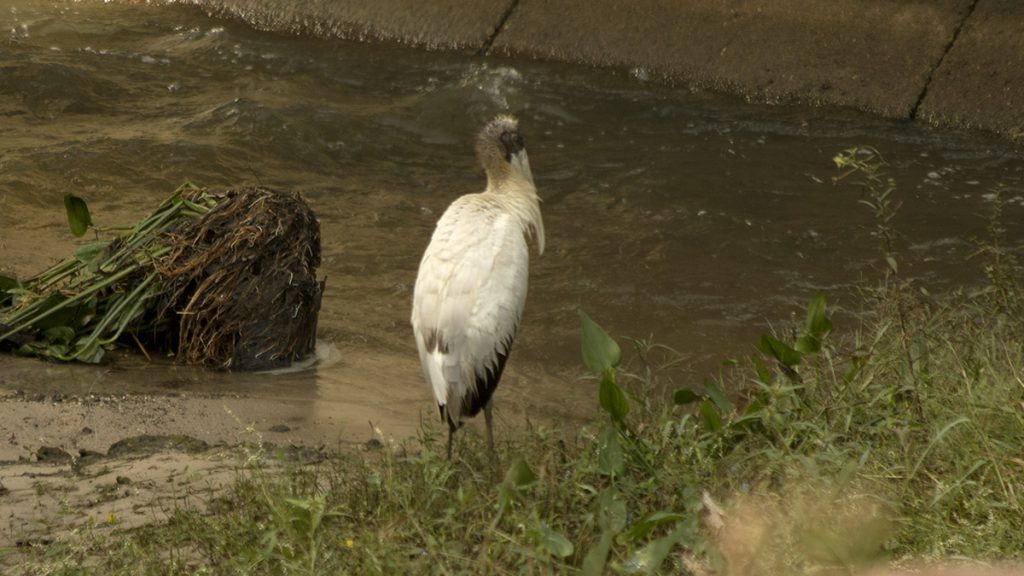
Juvenile wood stork (Mycteria americana) at Lake Elberta. You can identify it as such from the light grey feathers on its neck and head.
Wood storks are the dominant presence in the rookery. But, looking around, we start to notice other birds at different heights on the trees. The other birds that nest atop the trees are great blue herons. They are solitary nesters, and do not share trees with wood storks.
Just below storks, we see anhinga. Unfortunately, the anhinga we see today are backlit, so we miss out on seeing their breeding plumage. Luckily, I happened to see a nesting pair on a trip to the Everglades a few months ago.
And then, just a few feet above the water, we find a great egret nest. “In fact, it’s so low that a large alligator could virtually leap up and get the young out of the nest, although I’ve never seen that happen.” We didn’t see any green herons, but Jim says they tend to nest 6-8 feet above the water.
Animals We See in the Video
00:03 Two Black Bellied Whistling Ducks (Dendrocygna autumnalis) on a cypress branch directly behind Jim and Tara’s house. They nest in tree cavities, like wood ducks, and both species regularly nest here.
00:05 Dragonfly on a blade of grass, likely a Blue Dasher (Pachydiplax longipennis). Jim pointed out that even though swamps are large pools of standing water, when we’re in the sunlight, dragonflies take care of mosquitos.
00:08 Wood stork (Mycteria americana) next to a nest. You can see a smaller nest to the left.
00:11 Two anhinga (Anhinga anhinga) stretch their wings. You’ll often see anhinga, and their cousin cormorants, swimming alongside ducks. However, their feathers aren’t as water proof as ducks, which is why they spend so much time drying their wings in the sun.
00:14 The swamp directly behind Jim and Tara’s. Note the wood duck box on the left.
00:40 In front of several foraging wood storks, a juvenile has a branch taken away from it by a black vulture (Coragyps atratus). Footage provided by Tara Tanaka.
00:52 A good perspective of the rookery provided by Tara Tanaka.
01:00 A mixture of wading birds forage behind Jim and Tara’s home: Wood storks, great egrets, snowy egrets, and ibis. Many of the storks we see have grey fuzzy heads, juveniles. Again, Tara’s footage.

A mix of great egrets (tall with yellow beaks), snowy egrets (shorter with black beaks and black legs), ibis (long, curved orange beaks), and juvenile wood storks (tall and bulky, black heads covered with grey downy fuzz) forage in shallow water. Provided by Tara Tanaka.
01:05 A good look at two adjacent wood stork nests with chicks and adults, provided by Tara.
01:15 Great Blue Heron (Ardea herodias) atop a cypress tree.
01:21 Anhinga with fish at Lake Elberta.
01:32 Great egret (Ardea alba) on nest.
02:30 American alligator (Alligator mississippiensis) half in the water. Provided by Tara Tanaka.
02:37 One of the more compelling shots Tara provided us, an alligator eating a wood stork Tara calls this shot “The Price of Protection.”
2017-07-18 The Price of Protection from Tara Tanaka on Vimeo.
02:43 Some shots of wood storks at Lake Elberta
03:17 Belted Kingfisher (Ceryle alcyon) atop the wood duck box.
03:27 Maryland meadow beauties (Rhexia mariana) in Jim and Tara’s backyard.



